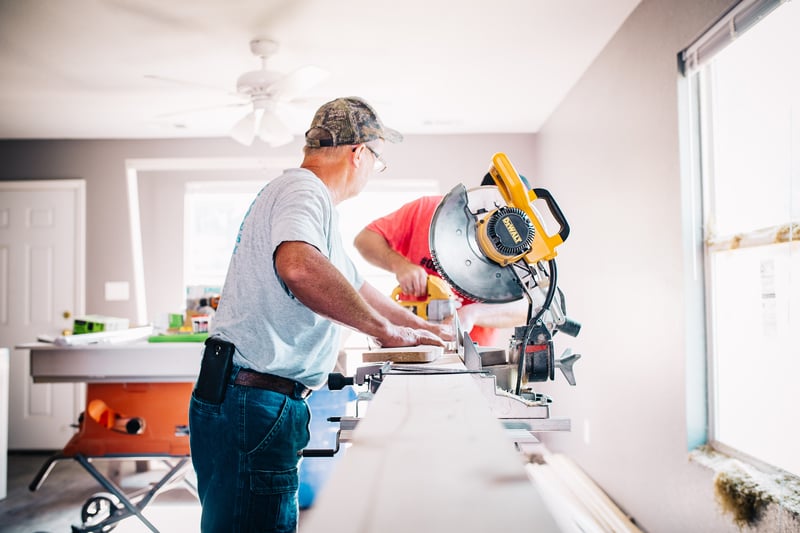
The risk of injury is pervasive throughout the entire woodworking industry, but studies show woodworking accidents may occur when using the following three types of machines: circular saws, wood shapers and surface planers.
When supervising construction projects with carpenters or joiners, you can significantly curtail your employees’ risk by learning standard safety solutions and urging the adoption of best practices when working with common types of dangerous machinery. Use the following solutions to reinforce uniformly safe behaviour for your employees when working with woodworking machines.
Safety Solutions
Your construction business can implement several company-wide solutions to combat common accidents and injuries. These safety solutions can be applied to many different types of machines and, in some cases, may be required.
- Braking devices prevent injuries resulting from workers accidentally touching tools that are running down but have not stopped moving. Workers will often switch off the machine and leave it unattended while it runs down, creating an unmanaged risk. Braking devices limit rundown times for cutting tools. If your risk assessment determines that your machine needs a braking device, you may be required to purchase one.
- Chip-limited tooling solutions lessen the possibility of a worker’s hands coming into contact with a machine’s rotating cutter. Chip-limited tooling restricts the projection of the cutter beyond the tool to 3 millimetres or less, leaving only a tiny gap where the cutter can slice a worker. Several hand-fed machines are sometimes required to be fitted with chip-limited tooling.
Best Practices for Common Woodworking Machinery
There are so many different varieties of machinery in the woodworking industry that it can be easy to lump them all together and apply the same best practices to each one—but that is dangerous thinking. In order to anticipate the majority of accidents that occur while using machines, you must consider each machine separately. The following are brief descriptions of and best practices for the most common types of machinery used by carpenters and joiners.
- Circular saws cause the most woodworking accidents, usually resulting in finger amputation. They are mostly used for cutting in line with the grain. Fit your circular saws with top guards and riving knives that are always adjusted for each new job. If your circular saws have a rundown time longer than 10 seconds, they should have a braking device. Rely on local exhaust ventilation (LEV) to control wood dust.
- Cross-cut saws are machines that have a blade mounted either above or below a table. Conduct a risk assessment to determine your cross-cut saw’s specific risks. All cross-cut saws should have a suitable cover and braking device. Establish a 300 millimetre “no go” area for hands on either side of the blade.
- Wood shapers produce grooving, moulding and rebating of curved and straight wood. You should fit your moulders with braking devices if they have a rundown time that exceeds 10 seconds.
- Surface planers create flat faces and square edges during the initial preparation of wood. Bridge guards protect workers’ fingers from touching the cutter—set yours to 10 millimetres or less, but always adjust the guard before each job so a non-uniform size does not jam the machine.
- Sanders smooth the surface of wood. The three main types are disc, spindle and belt. Each has its own risks, but all three create the need for wood dust management. Use a LEV system to extract harmful dust and a dust lamp to observe the dust your workers create and gauge your LEV system’s efficiency.
- Nail guns figure prominently in many aspects of woodworking; they are one of your employees’ most versatile tools. Workers should never keep their fingers on the trigger unless they are going to fire, and they should always wear eye protection in case of accidental ejection. The operator should never point the nail gun at themselves or others.
- Mortisers cut square or rectangular holes in timber. Workers should keep an 8-millimetre distance between the morticer’s chisel and their hands while using the machine. Require employees to use clamps to secure the wood they are cutting rather than holding it by hand, which can be unstable and dangerous.
Insist on Best Practices
The sheer number of safety solutions and best practices for woodworking, even just for the common machines, can be intimidating. But the inherent riskiness of the industry demands that you learn and communicate this information to your employees. Help them eliminate accidents in your workplace by insisting on adopting safety solutions and best practices.
Contact us at the Axis Insurance Group for help finding insurance and industry-specific solutions for your business.
Looking for additional ways to reduce health and safety hazards? Download our free Construction Content Package for tips and solutions for a safer job site!




